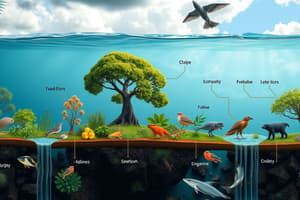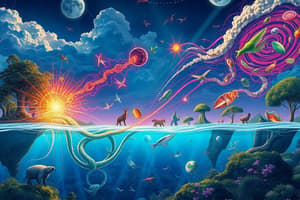Podcast
Questions and Answers
What percentage of energy is typically transferred from one trophic level to the next?
What percentage of energy is typically transferred from one trophic level to the next?
- 25%
- 10% (correct)
- 5%
- 50%
Which type of consumer primarily feeds on producers?
Which type of consumer primarily feeds on producers?
- Secondary Consumers
- Omnivores
- Tertiary Consumers
- Primary Consumers (correct)
What role do decomposers play in an ecosystem?
What role do decomposers play in an ecosystem?
- They compete with primary consumers for food.
- They break down dead organic matter and recycle nutrients. (correct)
- They introduce new species into the ecosystem.
- They serve as primary producers.
What is a trophic cascade?
What is a trophic cascade?
Which category includes organisms that consume both plants and animals?
Which category includes organisms that consume both plants and animals?
What is true about energy flow in ecosystems?
What is true about energy flow in ecosystems?
How can changes in one population within a food web affect other populations?
How can changes in one population within a food web affect other populations?
Which type of consumer are primary carnivores classified as?
Which type of consumer are primary carnivores classified as?
Which statement about autotrophs is accurate?
Which statement about autotrophs is accurate?
What describes secondary consumers in an ecosystem?
What describes secondary consumers in an ecosystem?
Flashcards are hidden until you start studying
Study Notes
Food Chain and Food Web
Energy Flow
- Energy flow in ecosystems begins with sunlight, which is captured by producers through photosynthesis.
- Energy is transferred from producers to consumers through various trophic levels.
- Only about 10% of the energy at one trophic level is passed on to the next; the rest is lost as heat.
- Energy flow is depicted in food chains and food webs, illustrating the direction and amount of energy transfer.
Producer-Consumer Relationships
- Producers (Autotrophs): Organisms that create their own food (e.g., plants, algae) using sunlight or chemical energy.
- Consumers (Heterotrophs): Organisms that rely on other organisms for food. Classified into various categories.
- Primary Consumers: Herbivores that feed on producers.
- Secondary Consumers: Carnivores that eat primary consumers.
- Tertiary Consumers: Predators that eat secondary consumers.
- Decomposers play a critical role by breaking down dead organic matter and recycling nutrients back into the ecosystem.
Ecosystem Dynamics
- Ecosystems can be stable or dynamic, often influenced by food chains and webs.
- Changes in one population (e.g., a decline in a predator) can have cascading effects throughout the food web.
- Biodiversity contributes to ecosystem resilience, enabling it to withstand changes and disturbances.
- Trophic cascades can occur when the removal or addition of a top predator impacts multiple levels of the food web.
Types of Consumers
- Herbivores: Consume plants and are primary consumers.
- Carnivores: Eat other animals; categorized into:
- Primary Carnivores: Eat herbivores.
- Secondary Carnivores: Eat other carnivores.
- Omnivores: Consume both plants and animals, functioning at multiple trophic levels.
- Detritivores: Feed on decomposing organic matter, contributing to nutrient cycling.
- Decomposers: Breakdown dead organisms and waste products, returning nutrients to the soil.
Energy Flow
- Energy in ecosystems originates from sunlight, utilized by producers via photosynthesis.
- Energy transfer between trophic levels is inefficient, with approximately 10% of energy passed to the next level while 90% dissipates as heat.
- Food chains and food webs demonstrate the pathways and magnitude of energy flow within ecosystems.
Producer-Consumer Relationships
- Producers (Autotrophs): Organisms like plants and algae that synthesize food using sunlight or chemical energy.
- Consumers (Heterotrophs): Depend on other organisms for nutrition, categorized as:
- Primary Consumers: Herbivores that directly consume producers.
- Secondary Consumers: Carnivores that predate on primary consumers.
- Tertiary Consumers: Predators that hunt secondary consumers.
- Decomposers: Essential for breaking down dead organisms, they recycle nutrients back into the ecosystem.
Ecosystem Dynamics
- Ecosystems can exhibit stability or dynamism, influenced by complex interactions in food chains and webs.
- Population changes, such as a predator's decline, can trigger cascading effects throughout the food web.
- High biodiversity enhances ecosystem resilience, allowing it to better withstand disturbances.
- Trophic cascades occur when alterations in a top predator's population affect various levels of the food web.
Types of Consumers
- Herbivores: Primary consumers that feed solely on plants.
- Carnivores: Animals that consume other animals, further divided into:
- Primary Carnivores: Predators of herbivores.
- Secondary Carnivores: Predators of other carnivores.
- Omnivores: Organisms that eat both plants and animals, occupying multiple trophic levels.
- Detritivores: Organisms that feed on decomposing organic matter, playing a key role in nutrient cycling.
- Decomposers: Microorganisms that decompose dead matter and waste, reinstating nutrients into the soil.
Studying That Suits You
Use AI to generate personalized quizzes and flashcards to suit your learning preferences.




